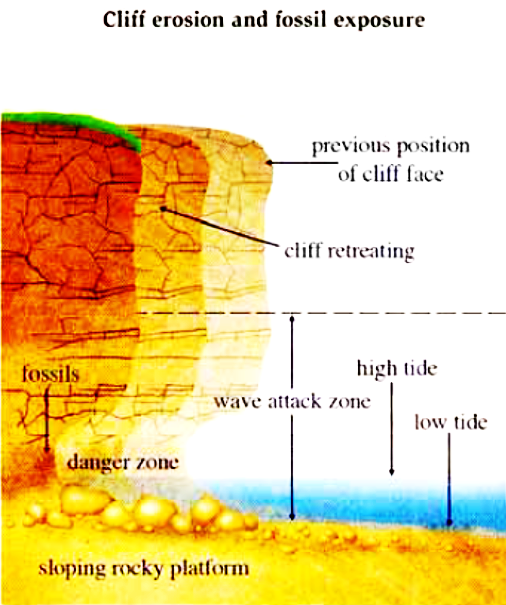The diagram below illustrates how fossils were exposed beneath a cliff as a result of coastal erosion. Summarize the information by describing the main features and make comparisons where relevant.

The 1st version of band 8+
(Taken from Complete IELTS bands 6.5-7.5)
The diagram shows the changes that took place in a cliff face as a result of coastal erosion, and how this led to the discovery of fossils
At one time the cliff stood much further out, and at low tide the sea water did not touch the base of the rock. Conversely, at high tide, the waves sometimes reached half way up the cliff wall. Eventually, the power of these waves loosened and wore away at the rock. This meant that stones and boulders fell into the sea and the cliff slowly retreated, exposing previously buried rock at low tide.
As the waves hit the lower part of the cliff more frequently, this area eroded more quickly and became a hollow in the cliff wall where fossils could be found. Meanwhile, the overhanging cliff at the top cracked creating a dangerous area beneath it.
Clearly, the fossils would have remained buried would have remained buried and the coastline unchanged if it had not been for the action of the sea.
Dịch: Ban đầu vách đá đứng xa ra ngoài biển thủy triều thấp không đụng được à khi thủy triều cao sóng đánh cao đến nửa vách đá à đá rời ra, bị bào mòn, rơi xuống à vách đá bị đẩy lui làm lộ ra phần đá bên trong. Do sóng đánh vào phần chân vách đá nhiều hơn à mòn nhanh hơn, tạo chỗ hõm, nơi ta thấy hóa thạch…
(version này tập trung lý giải sự bào mòn từng lớp dần dần lộ ra lớp trong. Phần 2nd version sẽ giải thích chân đá bị mòn hõm vào mất lực chống làm phần trên sập xuống)
The 2nd version of band 8+
The diagram describes the process that tides and waves eroded a cliff to reveal fossils at its core.
The erosion forces comprise high tides and waves. High tides seemed to attack the rock surface of the cliff most frequently when they always submerged the rock base in salt water. This is why the hollow part was usually most evident at the foot of the cliff. Meanwhile, the waves hit the cliff at half of its height escalating the erosion power by sea water.
After a certain time, when the foot was severely damaged, the cliff’s upper part had no more support and fell down to create a sloping rocky platform underwater where lies the danger zone. The sea-front surface of the cliff went through this process of degradation and thus became worn and retreated many times before the core fossils was revealed.
In general, under the sea water force, the cliff was eroded gradually to shed off the outer layers of rock and reveal the core of fossils deep inside.
Dịch: Nhân tố bào mòn gồm thủy triều cao và sóng. Triều cao ngâm chân vách đá trong nước muối à phần chân bị ăn mòn nhiều nhất, trong khi sóng đánh cao đến nửa vách đá gia tăng sự bào mòn từ biển lên vách đá. à Sau 1 thời gian, phần chân vách đá bị bào mòn nghiêm trọng, hõm vào, không còn sức đỡ cho phần đá phía trên, nên phần trên rơi xuống tạo thành dốc đá dưới chân vách, đây cũng là vùng nguy hiểm. Mặt giáp biển bị bào mòn và lùi lại nhiều lần trước khi hóa thạch lộ ra.
